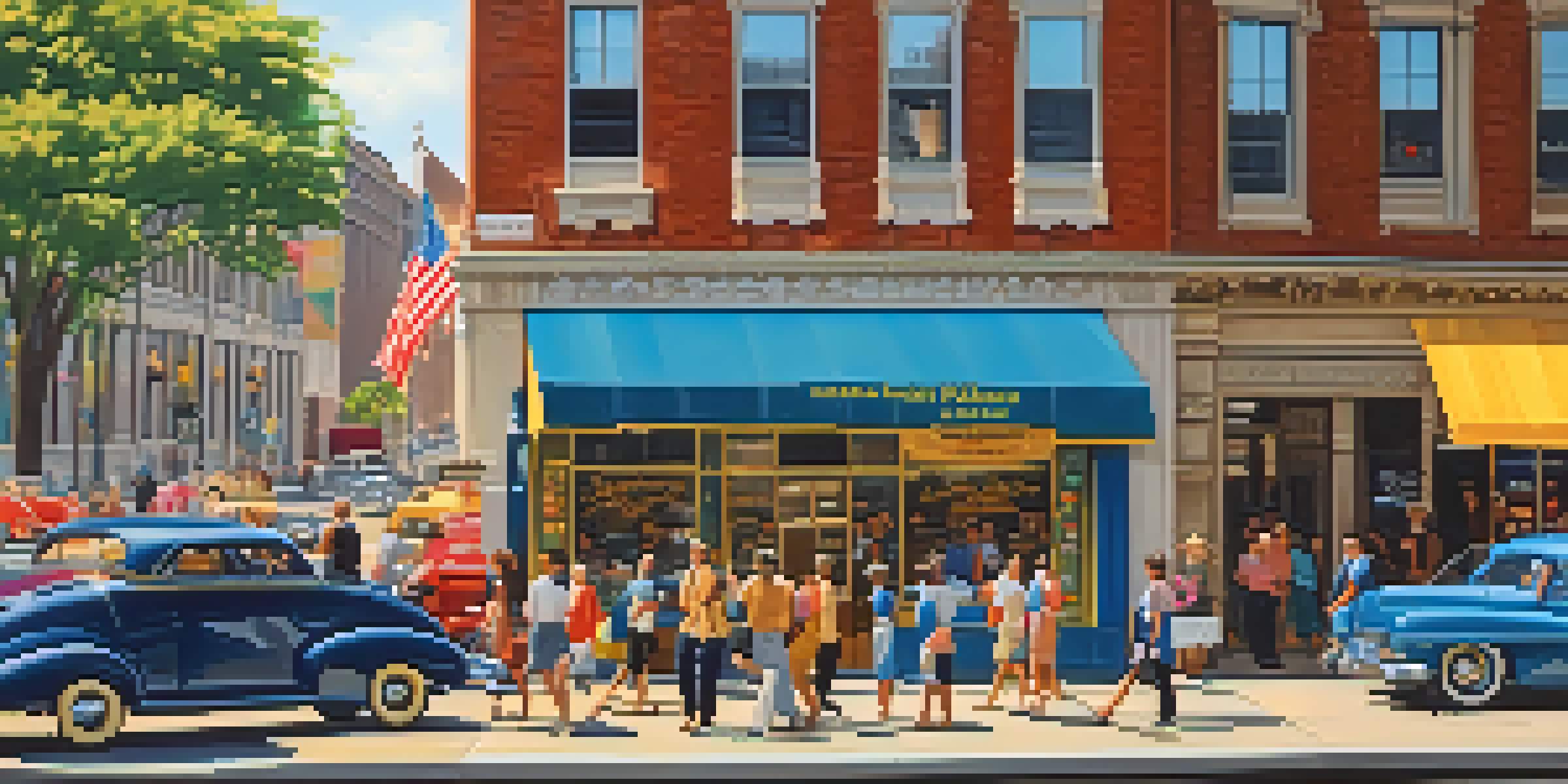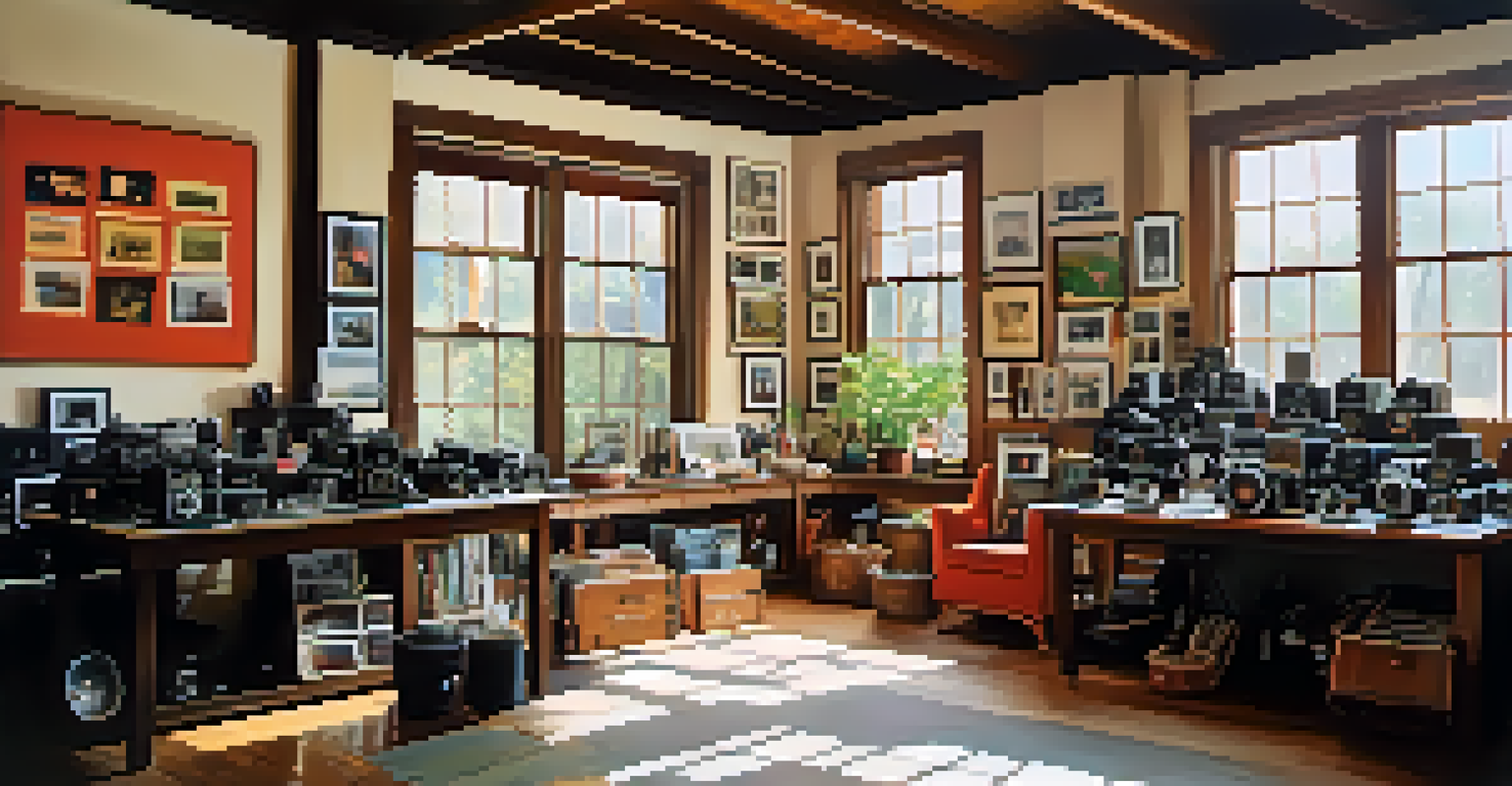Rochester's Contributions to Color Photography Advancements

The Birthplace of Color Photography: Rochester's Legacy
Rochester, New York, is often hailed as the birthplace of modern color photography, thanks to the pioneering work of local inventors and companies. The city became a hub for innovation, attracting talented individuals who sought to revolutionize the way we capture images. In the late 19th and early 20th centuries, Rochester's influence began to take shape with significant advancements in photographic technology.
Photography is the story I fail to put into words.
One of the most notable contributions came from George Eastman, who founded Eastman Kodak Company in 1888. Eastman's vision was to make photography accessible to everyone, and his innovations in film and processing laid the groundwork for color photography. By introducing roll film, he made it possible for amateur photographers to capture their memories without the complexities of earlier methods.
As Kodak grew, so did the city’s reputation as a center of photographic excellence. Rochester became synonymous with the evolution of photography, drawing in talent and fostering an environment ripe for creative exploration. This legacy continues to influence the field of photography to this day.
Key Innovations by George Eastman and Kodak
George Eastman's most impactful innovation was the development of the first commercially viable color film, Kodachrome, introduced in the 1930s. This film allowed photographers to capture vibrant colors in a way that was previously unimaginable. Kodachrome quickly became popular among both professionals and amateurs, as it produced rich, detailed images that stood the test of time.

Eastman understood that for photography to truly flourish, it needed to be simple and user-friendly. He focused on creating cameras that were lightweight and easy to operate, thus encouraging more people to engage with the art of photography. This accessibility was a game changer, leading to a boom in color photography during the mid-20th century.
Rochester: Birthplace of Color Photography
Rochester, New York, is recognized as the birthplace of modern color photography, primarily due to the groundbreaking work of George Eastman and Kodak.
In addition to Kodachrome, Kodak introduced a range of other color films that pushed the boundaries of what was possible in photography. Their ongoing commitment to research and development helped establish Rochester as a leading force in the global photography market, influencing countless photographers along the way.
The Role of Rochester’s Educational Institutions
Rochester is home to several renowned educational institutions, such as the Rochester Institute of Technology (RIT), which has played a pivotal role in advancing photographic education. RIT's School of Photographic Arts and Sciences has trained generations of photographers, equipping them with the skills needed to push the boundaries of the medium. The school’s emphasis on both technical and artistic aspects of photography has fostered innovation and creativity.
A camera is a save button for the mind's eye.
In addition to academic programs, RIT has also contributed to research in color photography. Faculty and students have engaged in projects that explore new techniques and technologies, further solidifying Rochester's reputation as a center for photographic advancement. The collaborative environment encourages experimentation, leading to groundbreaking discoveries in color imaging.
Through workshops, exhibitions, and community outreach, these institutions have not only educated individuals but also strengthened the local photography community. This vibrant ecosystem has ensured that Rochester remains at the forefront of photographic innovation, nurturing talent that will continue to shape the future of the art.
Impact of Color Photography on Society and Culture
The advancements in color photography from Rochester have had a profound impact on society and culture. Color images became a powerful medium for storytelling, allowing photographers to convey emotions and narratives in ways that black-and-white images could not. This shift changed how people experienced the world, making photography a crucial part of personal and public expression.
As color photography became more accessible, it transformed industries such as advertising, fashion, and journalism. Brands began to understand the power of color in capturing consumer attention, leading to a new era of marketing strategies. Color photography helped shape cultural trends, making it an integral part of how we perceive and engage with the world around us.
Impact on Society and Culture
The advancements in color photography transformed personal expression and industries like advertising and journalism, making color images a vital part of contemporary culture.
Moreover, the proliferation of color photography in family albums and everyday life fostered a sense of nostalgia and connection. People began to document their lives in vivid detail, preserving memories that could be shared across generations. This cultural shift is one of Rochester's most lasting legacies in the realm of photography.
Rochester’s Influence on Professional Photography
Rochester's contributions to color photography have not only impacted amateurs but have also significantly influenced professional photographers. The high-quality color films produced by Kodak set the standard for the industry, making it easier for professionals to deliver stunning images to clients. As a result, many photographers sought to master the art of color photography, leading to a thriving market for professional services.
In addition to technical advancements, Rochester nurtured a community of photographers who collaborated and shared their knowledge. This environment fostered mentorship and inspiration, helping professionals refine their craft and push creative boundaries. Photographers from around the world continue to visit Rochester, drawn by its rich history and ongoing innovations in the field.
The legacy of Rochester's contributions to professional photography is evident in the work of renowned photographers who have called the city home or been inspired by its advancements. Their achievements serve as a testament to how the city's innovations have shaped the trajectory of photography as an art form.
Preserving Rochester’s Photographic Heritage
As the birthplace of color photography, it's essential to preserve Rochester's rich photographic heritage for future generations. Museums and archives in the city, such as the George Eastman Museum, play a crucial role in this endeavor. They house extensive collections of historical photographs, cameras, and films that tell the story of photography's evolution and the contributions of Rochester's innovators.
The George Eastman Museum, in particular, serves as a global center for photography research and education. It offers exhibitions, workshops, and programs that engage the community and celebrate the art of photography. By showcasing Rochester's contributions, the museum ensures that the legacy of color photography continues to inspire and educate.
Future of Photography in Rochester
Rochester continues to foster innovation in color photography through education and emerging technologies, ensuring its legacy remains influential in the art form.
Preservation efforts also extend to local initiatives that encourage artists and photographers to explore and document their surroundings. By fostering a culture of appreciation for photographic history, Rochester continues to honor its legacy while inspiring new generations of creators to contribute to the ever-evolving world of photography.
The Future of Color Photography in Rochester
As we look to the future, Rochester remains a vibrant hub for color photography innovation. Emerging technologies, such as digital imaging and artificial intelligence, are reshaping the landscape of photography and presenting new opportunities for creativity. Local photographers and institutions are at the forefront of these advancements, exploring how they can integrate these tools into their artistic practices.
Rochester's strong commitment to education and collaboration ensures that the spirit of innovation continues to thrive. With institutions like RIT leading the charge, students and professionals are experimenting with new techniques and pushing the boundaries of color photography. This culture of exploration is essential for keeping the city's legacy alive and relevant in an ever-changing industry.

Ultimately, Rochester's contributions to color photography have laid a solid foundation for the future. As new technologies emerge and artistic expressions evolve, the city will undoubtedly continue to play a pivotal role in shaping the next chapter of color photography, inspiring photographers around the globe.